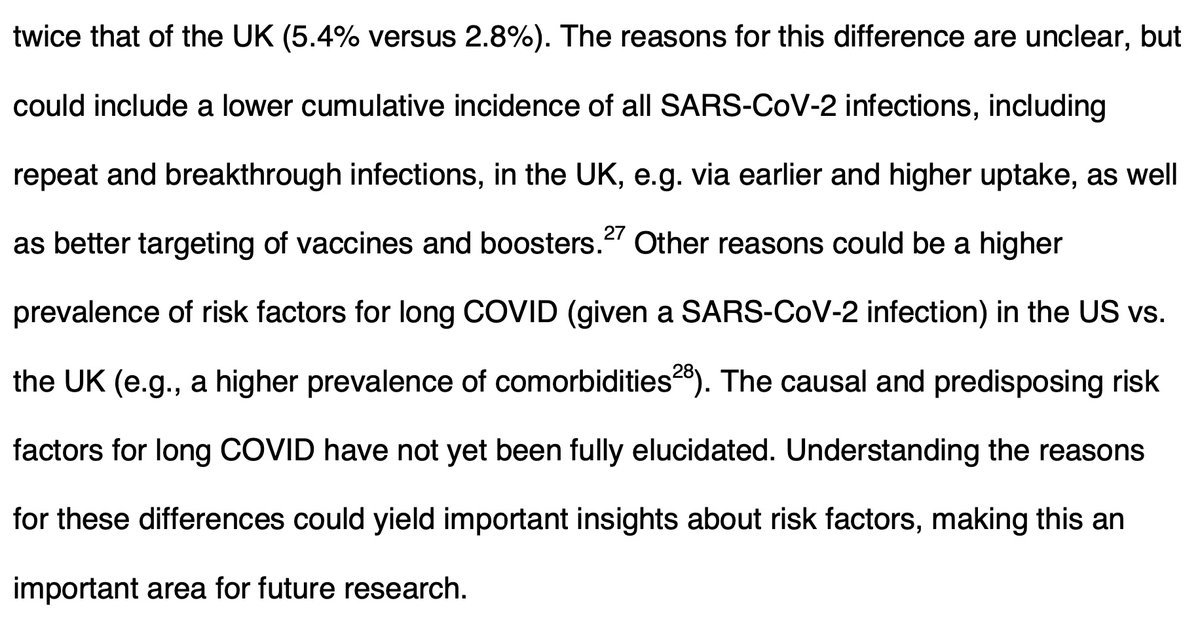
Our pre-print on "The epidemiology of long COVID in US adults two years after the start of the US SARS-CoV-2 pandemic". 7.3% of the US adult population (~18.5 million) reported having long COVID by July. What does the epidemiology look like? bit.ly/CUNYlongcovid [thread]
Persistence of symptoms: One-quarter (25.3% [18.2-32.4%]) of respondents with long COVID reported their day-to-day activities were impacted 'a lot' and 28.9% had SARS-CoV-2 infection >12 months ago.
The age- and sex-adjusted prevalence of long COVID was higher among respondents who were female (aPR: 1.84 [1.40-2.42]), had comorbidities (aPR: 1.55 [1.19-2.00]) or were not (versus were) boosted (aPR: 1.67 [1.19-2.34]) or not vaccinated (versus boosted) (aPR: 1.41 (1.05-1.91)). 

Long COVID prevalence was lower in those aged 18-24 (vs. 25-34)(aPR: 0.50 [0.30-0.84]), aged 65+ (vs. 25-34) (aPR: 0.43 [0.27-0.66]), Black NH (vs. White NH) (aPR:0.60 [0.38- 0.96]), Hispanic (vs. White NH) (aPR:0.57 [0.37-0.89]), or API NH (vs. White NH) (aPR:0.44 [0.21-0.93]). 

Our estimate of prevalence (7.3% among adults) is more than twice that of the UK (2.8% among those 2 and older). To compare, if no US children or adolescents aged 2-17 years have long COVID, the prevalence of long COVID among those aged 2+ would be approximately 5.4%. Why? 

Identifying groups at higher risk for long COVID is key to managing the long term impacts of the COVID-19 pandemic. Many studies of long COVID risk factors are among hospitalized or care-seeking populations, which overrepresent those with comorbidities and health care access.
Some differences were observed in the risk factors for long COVID versus those for SARS-CoV-2 infection. e.g., while females were less likely to have ever had SARS-CoV-2 infection, they were much more likely to have long COVID more than 2 years into the US pandemic.
We found that the duration of long COVID symptoms extends to more than 12 months for many people, but that the impact of long COVID on daily living decreases with time since the most recent infection, suggesting possible improvement in long COVID symptoms over time.
Strengths include the representative and probability-based design of the survey, the ability for the survey to reflect outcomes among those who do not access the healthcare system for their COVID infection(s) or long COVID, and the use of similar long COVID questions to the UK.
Our findings underscore the importance of using a nationally-representative sample to obtain estimates of disease burden when passive surveillance cannot. Such approaches may be helpful for current and future infectious disease outbreaks and pandemics.
@EricTopol @ahandvanish @VirusesImmunity @zeynep @angie_rasmussen @CUNYSPH @CUNYResearch @cunyisph @CDCDirector @ashishkjha
• • •
Missing some Tweet in this thread? You can try to
force a refresh




